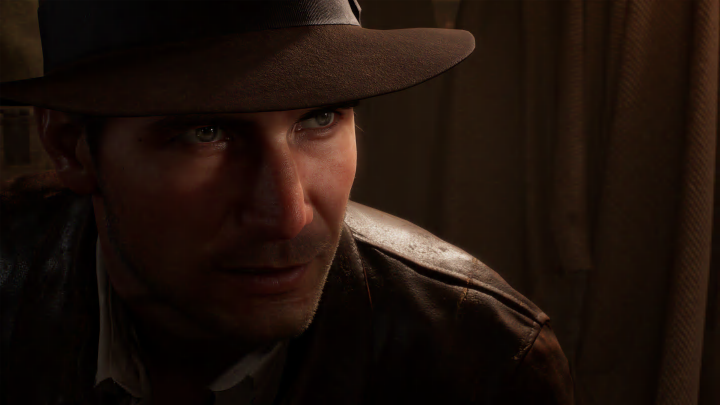Indiana Jones and the Great Circle looks like a true successor to The Chronicles of Riddick

Before 2004, expectations for licensed games were lower than the Mariana Trench. Then came The Chronicles of Riddick: Escape from Butcher Bay, a stealth shooter focused on melee combat that put you behind the blacked-out goggles of Vin Diesel’s murderous antihero. This prequel to Pitch Black was much better than the movies it was based on – a far cry from the cynical cash grabs usually pumped out.
The game told a story separate from the movies, putting you in the middle of a prison break. It featured cutting-edge HUD-free visuals and used clever camera cutaway techniques when you performed certain actions, creating an exciting blend of Half-Life and Splinter Cell. The Starbreeze Studios-developed title raised the bar for every licensed video game to launch since. With Indiana Jones and the Great Circle, MachineGames is reaching back into its bag of tricks.
The founding members of MachineGames, best known for its Wolfenstein games, all worked on The Chronicles of Riddick at Starbreeze, and you can see that lineage in every frame of the gameplay presentation shown to the press last week. While it wasn’t hands-on, what I saw made me forget how much I want Wolfenstein 3.
Indiana Jones and the Great Circle is shaping up to be something special.
Packed full of globe-trotting matinee set pieces from the Vatican to the Himalayas and the Temples of Sukhothai, Indy delves into tombs, jumps on top of hulking zeppelins, whips fascists, fights across warzones, and treks through dense jungle on a proper adventure – all while Troy Baker does a pitch-perfect Harrison Ford impersonation. But there’s more to Indiana Jones and the Great Circle than shooting, whipping, and quipping.
Exploring by torchlight through ancient crypts and lost civilizations, the game is as much about discovery as it is about slapping Nazis. MachineGames’ developers say they were inspired by classic point-and-click adventure games for Indy’s puzzles, which manifests in finding clever uses for tools. In one scene, Indy pours a bottle of wine from his inventory into a recess to trigger a mechanism, and in another, he uses a lit torch to burn away a blockage from a small entrance.
Indy is joined by Gina, an Italian journalist who’s looking for her sister. Using her camera, you can take photos of every discovery you find, unlocking progression points and adding the images to your journal, which acts as a living diary of your adventures – maps, letters, and your snaps litter the pages by the time the credits roll.
As with torches and other tools, Indy’s whip also serves multiple purposes. You can use it to disarm and subdue enemies – in one scene, he whips at a Nazi so hard that it breaks the wooden chair sitting next to him – but it’s also used for traversal, during which the camera cuts back to third-person. In another scene, Indy throws spears into a wall to create makeshift grapple points to cross a chasm.
The Chronicles of Riddick comparisons don’t begin and end with the camera cutting away to third-person in a licensed game, though. While Indiana Jones is a linear adventure, those more focused levels are broken up with little hub areas and wider stealth arenas. The hub areas allow you to explore freely and talk to people or purchase items at shops without the threat of taking a bullet. Then there are areas where there are enemies, but they’re unaware of you, allowing you to swing, sneak, and climb around them while thinning their ranks with stealth takedowns and distractions.
Stealth also materializes in disguises, which you can use to access restricted areas without pulling out your revolver. During these, you must avoid specific enemies who can see through your disguise while heading toward your goal and blending in. At one point, Indy heads into a Nazi tent to grab a key, and an officer shouts at him to fetch him a bottle, getting more irate the longer he takes. Presumably, you’ll alert them if you’re not fast enough, but Demo Indy gets the key and hands him a bottle in the nick of time.
When things do kick off, the action doesn’t disappoint. Gunplay looks hefty and impactful, affecting the environment as well as the enemies, and Indy has a range of throwable items and melee skills alongside his whip. Melee combat is built around timing, counters, and mixing up moves to land finishers and combos. He can also use a range of melee weapons, including shovels, hammers, and a rolling pin, and there’s a shove you can deploy to throw people over ledges, which is always fun. As you progress, you’ll also unlock traits, such as True Grit, which allows Indy to crawl to his hat and put it back on for another chance after being knocked down.
My disappointment that there’s no news on Wolfenstein 3 has completely melted away after seeing Indiana Jones and the Great Circle in action. It looks like it takes everything I love about MachineGames’ alternate history series – the varied gameplay and constant surprises combined with excellent writing and exciting action – and blends it with all the best parts of Chronicles of Riddick. There really is treasure in the vaults of history.
